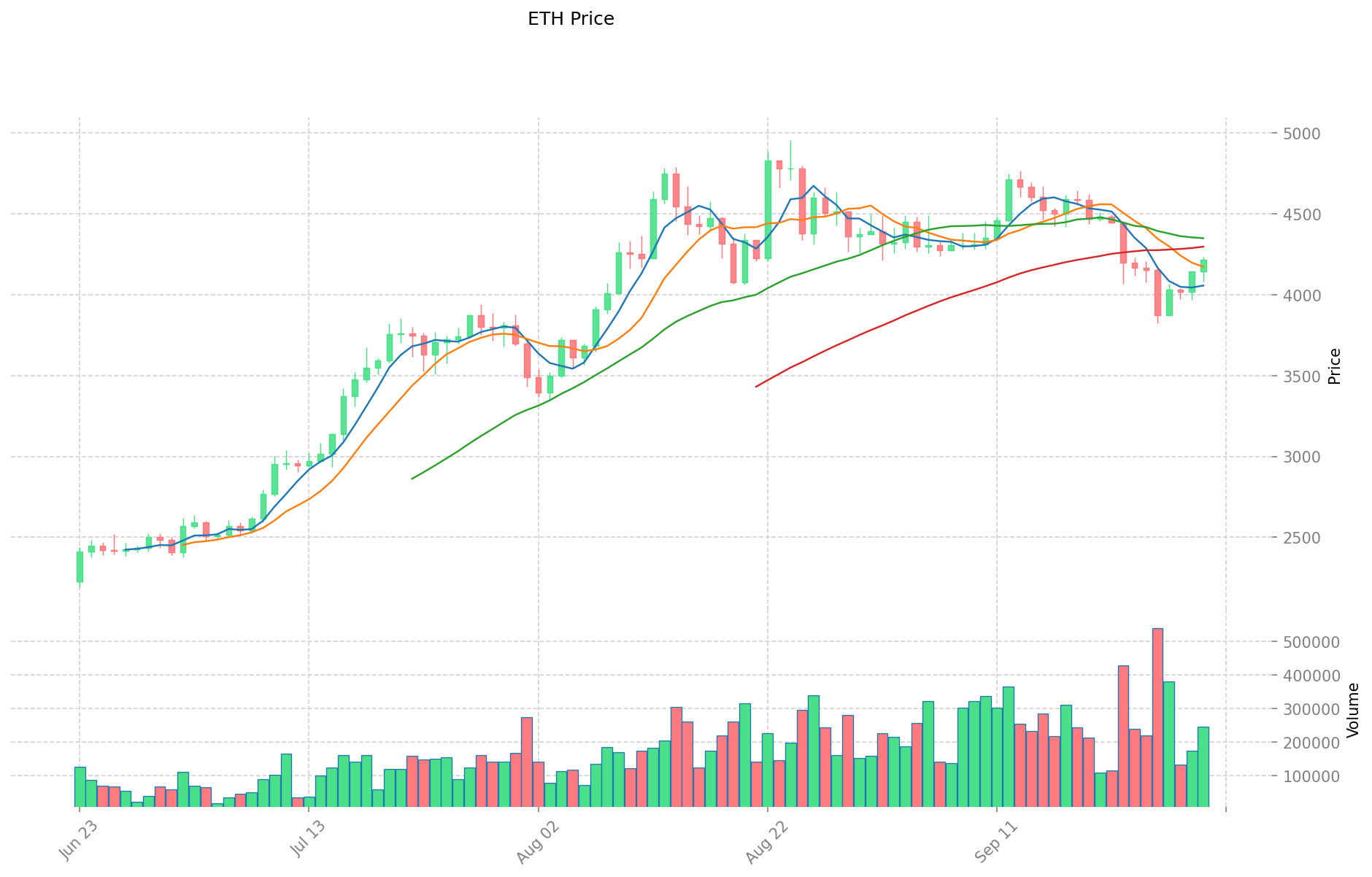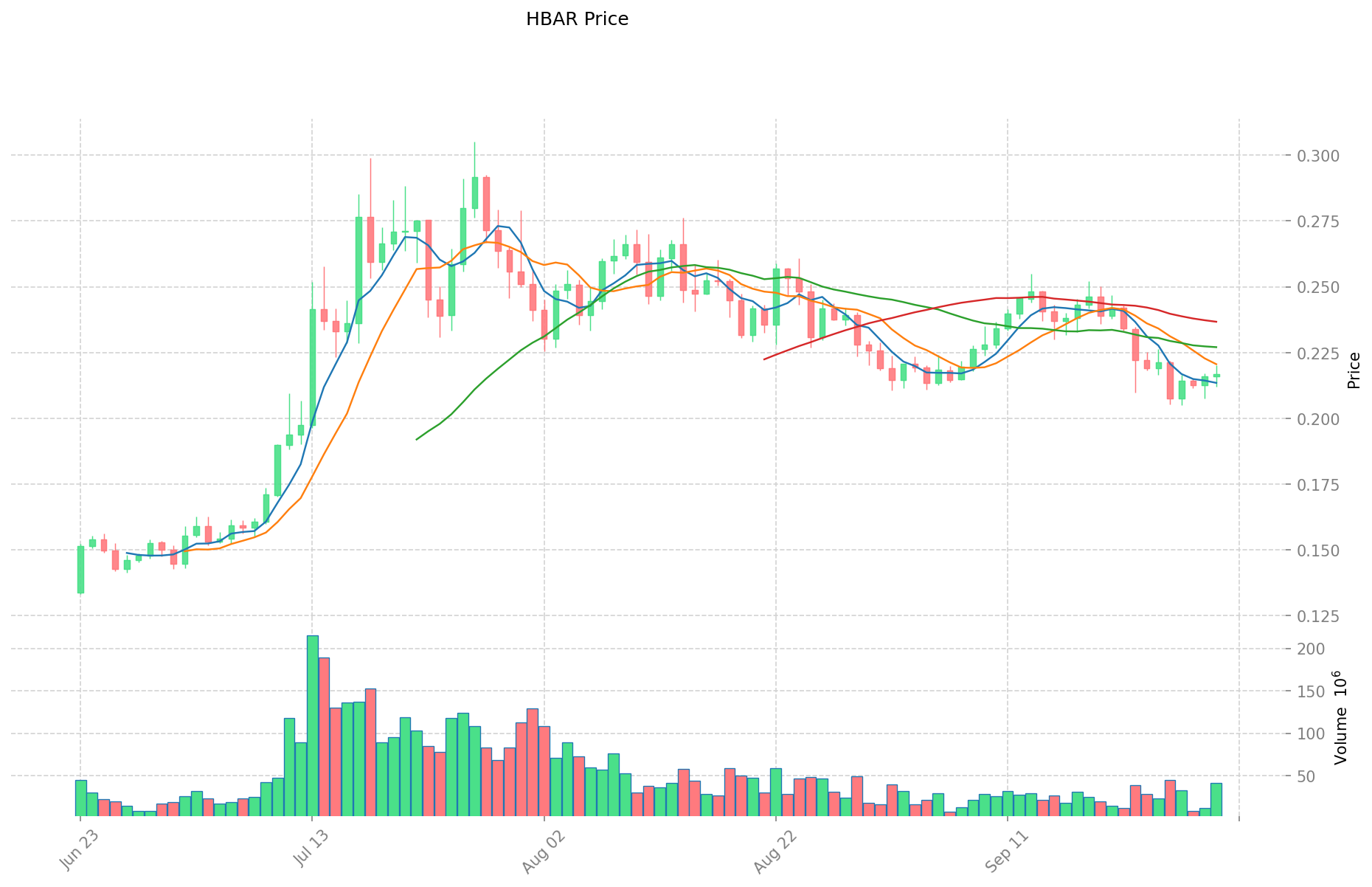ETH vs HBAR: Comparing Scalability Solutions in the Next Generation of Blockchain Technology
Introduction: ETH vs HBAR Investment Comparison
In the cryptocurrency market, Ethereum vs Hedera has always been a topic that investors can't avoid. The two not only have significant differences in market cap ranking, application scenarios, and price performance, but also represent different positioning in crypto assets.
Ethereum (ETH): Since its launch in 2015, it has gained market recognition for its support of smart contracts and decentralized applications (DApps).
Hedera (HBAR): Since its inception in 2019, it has been known for its high-speed, secure, and fair public ledger network using hashgraph consensus.
This article will comprehensively analyze the investment value comparison between ETH and HBAR, focusing on historical price trends, supply mechanisms, institutional adoption, technical ecosystems, and future predictions, attempting to answer the question investors care about most:
"Which is the better buy right now?"
I. Price History Comparison and Current Market Status
Ethereum (ETH) and Hedera (HBAR) Historical Price Trends
- 2021: ETH reached an all-time high of $4,946.05 due to increased DeFi and NFT adoption.
- 2022: HBAR experienced significant growth, with its price rising over 300% year-over-year.
- Comparative analysis: During the 2022 bear market, ETH dropped from its all-time high to around $1,000, while HBAR showed relative stability.
Current Market Situation (2025-09-30)
- ETH current price: $4,148.94
- HBAR current price: $0.21311
- 24-hour trading volume: ETH $1,103,804,089 vs HBAR $8,755,290
- Market Sentiment Index (Fear & Greed Index): 50 (Neutral)
Click to view real-time prices:
- View ETH current price Market Price
- View HBAR current price Market Price


Comparative Investment Analysis: ETH vs HBAR
I. Key Factors Influencing ETH vs HBAR Investment Value
Supply Mechanisms (Tokenomics)
- ETH: Utilizes a Proof of Stake (PoS) consensus mechanism that appeals to ESG-focused investors
- HBAR: Has planned token release with 50 billion tokens, value depends on utility growth outpacing supply pressure
- 📌 Historical Pattern: HBAR shows potential for 1300% growth cycles according to historical data
Institutional Adoption & Market Applications
- Institutional Holdings: ETH has significant institutional backing with BlackRock's ETF surpassing $10 billion
- Enterprise Adoption: HBAR is governed by a corporate consortium including Google, IBM, Boeing, and LG, positioning it as an enterprise-focused blockchain
- Regulatory Attitudes: HBAR ETF has received approval, distinguishing itself through enterprise-grade blockchain solutions and high-profile partnerships
Technical Development & Ecosystem Building
- ETH Technical Upgrades: Transition to PoS has strengthened market confidence in Ethereum's core advantages
- HBAR Technical Development: Features the unique Hashgraph consensus mechanism providing extremely low latency and high throughput
- Ecosystem Comparison: ETH has broader application base but faces challenges in DeFi sector despite price growth
Macroeconomic & Market Cycles
- Inflation Environment Performance: ETH attracts investors focused on long-term applications
- Monetary Policy Impact: Both assets' values are tied to market perception of their respective networks' future utility
- Geopolitical Factors: HBAR's long-term value (projected to 2050) will depend on Hedera network's role in the global digital economy
III. 2025-2030 Price Prediction: ETH vs HBAR
Short-term Prediction (2025)
- ETH: Conservative $3,745.53 - $4,161.7 | Optimistic $4,161.7 - $6,076.082
- HBAR: Conservative $0.1683253 - $0.21307 | Optimistic $0.21307 - $0.2705989
Mid-term Prediction (2027)
- ETH may enter a bullish market, with prices expected between $5,162.14562895 - $8,093.73450465
- HBAR may enter a growth phase, with prices expected between $0.1625127504 - $0.28947583665
- Key drivers: Institutional capital inflow, ETF, ecosystem development
Long-term Prediction (2030)
- ETH: Base scenario $10,671.581774734318125 - $13,766.340489407270381 | Optimistic scenario up to $13,766.340489407270381
- HBAR: Base scenario $0.394489481067556 - $0.41815884993161 | Optimistic scenario up to $0.41815884993161
Disclaimer: The information provided is for informational purposes only and should not be considered as financial advice. Cryptocurrency markets are highly volatile and unpredictable. Always conduct your own research before making any investment decisions.
ETH:
| 年份 | 预测最高价 | 预测平均价格 | 预测最低价 | 涨跌幅 |
|---|---|---|---|---|
| 2025 | 6076.082 | 4161.7 | 3745.53 | 0 |
| 2026 | 7627.14759 | 5118.891 | 3122.52351 | 23 |
| 2027 | 8093.73450465 | 6373.019295 | 5162.14562895 | 53 |
| 2028 | 10777.73158073925 | 7233.376899825 | 5063.3638298775 | 74 |
| 2029 | 12337.60930918651125 | 9005.554240282125 | 4953.05483215516875 | 117 |
| 2030 | 13766.340489407270381 | 10671.581774734318125 | 7470.107242314022687 | 157 |
HBAR:
| 年份 | 预测最高价 | 预测平均价格 | 预测最低价 | 涨跌幅 |
|---|---|---|---|---|
| 2025 | 0.2705989 | 0.21307 | 0.1683253 | 0 |
| 2026 | 0.266017895 | 0.24183445 | 0.14510067 | 13 |
| 2027 | 0.28947583665 | 0.2539261725 | 0.1625127504 | 19 |
| 2028 | 0.37766439635925 | 0.271701004575 | 0.2119267835685 | 27 |
| 2029 | 0.464296261667988 | 0.324682700467125 | 0.224031063322316 | 52 |
| 2030 | 0.41815884993161 | 0.394489481067556 | 0.268252847125938 | 85 |
IV. Investment Strategy Comparison: ETH vs HBAR
Long-term vs Short-term Investment Strategies
- ETH: Suitable for investors focused on ecosystem potential and DeFi applications
- HBAR: Suitable for investors interested in enterprise-grade blockchain solutions and long-term utility
Risk Management and Asset Allocation
- Conservative investors: ETH: 60% vs HBAR: 40%
- Aggressive investors: ETH: 75% vs HBAR: 25%
- Hedging tools: Stablecoin allocation, options, cross-currency portfolios
V. Potential Risk Comparison
Market Risks
- ETH: High volatility, susceptible to broader crypto market trends
- HBAR: Lower liquidity, potential supply pressure from token releases
Technical Risks
- ETH: Scalability issues, network congestion
- HBAR: Centralization concerns, potential security vulnerabilities
Regulatory Risks
- Global regulatory policies may impact ETH more due to its wider adoption and DeFi ecosystem
- HBAR might face less regulatory scrutiny due to its enterprise focus and corporate governance structure
VI. Conclusion: Which Is the Better Buy?
📌 Investment Value Summary:
- ETH advantages: Established ecosystem, institutional adoption, transition to PoS
- HBAR advantages: Enterprise partnerships, unique consensus mechanism, potential for high growth
✅ Investment Advice:
- Novice investors: Consider a balanced portfolio with a higher allocation to ETH for its established market position
- Experienced investors: Explore HBAR for potential high growth, while maintaining a significant ETH position
- Institutional investors: Evaluate both assets, with ETH for broader market exposure and HBAR for enterprise blockchain solutions
⚠️ Risk Warning: The cryptocurrency market is highly volatile. This article does not constitute investment advice. None
FAQ
Q1: What are the main differences between ETH and HBAR? A: ETH is a well-established platform for smart contracts and DApps, while HBAR focuses on enterprise-grade blockchain solutions with high speed and security. ETH uses Proof of Stake consensus, while HBAR uses the Hashgraph consensus mechanism.
Q2: Which cryptocurrency has shown better price stability? A: During the 2022 bear market, HBAR showed relative stability compared to ETH, which dropped significantly from its all-time high.
Q3: How do the supply mechanisms of ETH and HBAR differ? A: ETH uses a Proof of Stake mechanism that appeals to ESG-focused investors, while HBAR has a planned token release of 50 billion tokens, with its value depending on utility growth outpacing supply pressure.
Q4: What are the key factors influencing institutional adoption of ETH and HBAR? A: ETH has significant institutional backing, with BlackRock's ETF surpassing $10 billion. HBAR is governed by a corporate consortium including major companies like Google and IBM, positioning it as an enterprise-focused blockchain.
Q5: What are the long-term price predictions for ETH and HBAR by 2030? A: For ETH, the base scenario predicts $10,671 to $13,766. For HBAR, the base scenario predicts $0.39 to $0.42. However, these are speculative and should not be considered financial advice.
Q6: How should investors allocate their portfolio between ETH and HBAR? A: Conservative investors might consider 60% ETH and 40% HBAR, while aggressive investors might opt for 75% ETH and 25% HBAR. However, individual risk tolerance and investment goals should guide allocation decisions.
Q7: What are the main risks associated with investing in ETH and HBAR? A: ETH faces high volatility and scalability issues, while HBAR has lower liquidity and potential supply pressure. Both face regulatory risks, with ETH potentially more impacted due to its wider adoption in the DeFi ecosystem.
Share
Content